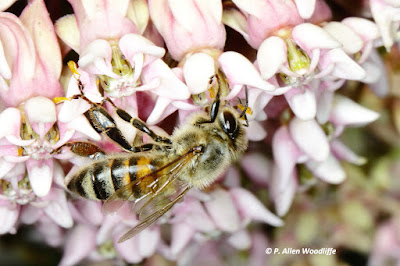Although local butterfly counts seem to be over for the season, it is always nice to get out and explore areas for them to see what is still around. I've been out in a few places, concentrating for the most part in areas where tallgrass prairie has been planted in the last decade or so.
Many of the sites I've visited don't have a lot of prairie grasses, but lots of forbs (wildflowers) which are attractive although in a healthy prairie, should make up only about 30%-40% of the total vegetation, not the 75-80% it seems that most newly planted prairies are made up of. There is a whole topic for a future post on prairie ecology there, to be sure, but that isn't the intent of this post....maybe a future one.
At this time of year, some of the most showy prairie wildflowers are:
 |
| Prairie Milkweed |
 |
| Butterflyweed |
 |
| Ohio Spiderwort |
 |
| Compass Plant |
 |
| Gray-headed Coneflower |
 |
| Mountain-mint |
Some of these plants are more preferred as nectaring plants than others. But they are all part of the prairie vegetation, and are great to see.
Most of the butterflies I was able to track down are not specific to prairies but were certainly enjoying what the prairie wildflowers had to offer. This Painted Lady was visiting a clump of Mountain-mint.
Another Painted Lady was enjoying the presumably tasty nectar of Black-eyed Susan.
Monarchs, of course, are probably the best known butterfly. This female was resting on a Gray-headed Coneflower
This Clouded Sulphur, with its vibrant pink edging, was sipping from a False Oxeye.
Common Wood-Nymphs are common to some degree, but they are most often seen flitting briskly over and through the vegetation. When they do land for a short time, they are often partially obscured and challenging to photograph.
Delaware Skippers seem to be fairly common in several places
Eastern Tailed Blues are common, but not always easy to photograph.
Sometimes it helps if they are distracted by something else.
Viceroys are not plentiful, but are seen occasionally right now.
A butterfly I don't see often is this next one: Common Sootywing. Being as small (about 21-27mm or about one inch) and as skittish as it is, it isn't often seen by anyone I expect. I only managed to get a couple of distant shots, and this one is greatly cropped.
While it isn't a prairie site, the Reid Conservation Area north of Wallaceburg is a great spot for butterflies. I managed to catch up to a few Banded Hairstreaks earlier, but missed the Oak Hairstreak the site is known for. Apparently it wasn't a good year for the Oaks. Just yesterday I stopped by again, and saw several species, including Great Spangled Fritillary, Eastern Comma and a Least Skipper, among others.
 |
| Least Skipper |
I had been hoping for a Duke's Skipper, and am quite sure I saw one, albeit briefly. However the evenly dark upper wing surface and the dark under surface with the telltale wide pale band going the length of the hindwing were fairly convincing. When photographing skippers up close, one has to move slowly. Unfortunately on this occasion, I either didn't move slowly enough and spooked the little rascal or I didn't move fast enough since just as I was focusing on it, it decided to skedaddle, and in spite of searching for it, did not see it again.
There are always lots of other things to be on the lookout for, especially when there is a lull in butterfly action. On some occasions I have seen lots more dragonflies than butterflies. It has been a good year for both of these next two species.
 |
| Eastern Pondhawk |
 |
| Halloween Pennant |
 |
| Pennant pair in wheel |
This next one is attractive as well but not nearly as common as the previous ones.
 |
| Calico Pennant |
There are lots of moths to be found in prairies. One usually encounters them as they scurry away and hide, after being spooked when one is walking through the vegetation. The critter in this next photo is a Hummingbird Clearwing, a member of the Sphinx moth group, and can be seen flying in broad daylight. This one is sipping on Wild Bergamot.
Just to add a little more diversity to this post, I will include a photo of a Green Frog, one of the more common frog species of southern Ontario. I found several cooling off in a puddle near a prairie.
And what would a hike in the vicinity of prairies and wetlands be without a photo of a snake. This photo is of a medium sized adult Eastern Fox Snake, an endangered species in Ontario. It was quite approachable, and a close look may explain why. Note the eye on the left side of the critter. It is whitish, which means it is getting ready to shed. The outermost layer of skin, which is about to be shed, includes the covering of the eye, so at this point the eyes are cloudy and the snake has very poor eyesight. Also take a look at the right hands side of the snake's mouth and notice that it looks slightly askew.

A closer look at this right hand side of the snake's head shows, in this next photo, that it has been damaged, and there is no eye at all! Clearly this snake has had a serious injury at some point, but it has healed over and the snake has survived. Fortunately for the snake, they have a keen sense of smell, so in spite of the poor eyesight, it can still find some food. However this individual has had more than its share of challenges to survive.










































































